Steven Mace's Blog, page 4
June 2, 2014
Publication News: Unlimited Shelf Life in Aphelion Webzine
My Fantasy/SF short story "Unlimited Shelf Life" has been published in Aphelion Webzine.
It's a humorous Speculative Fiction/Fantasy tale, with a theme of corporate satire, combined with superhero adventure. Think of this story as Mad Men Meets Marvel. You can read this story here.
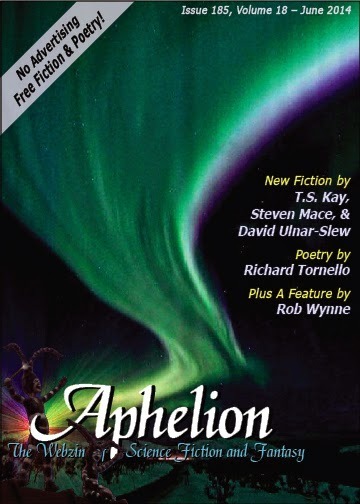
It's a humorous Speculative Fiction/Fantasy tale, with a theme of corporate satire, combined with superhero adventure. Think of this story as Mad Men Meets Marvel. You can read this story here.

Published on June 02, 2014 12:30
May 5, 2014
Publication News: The Foreshadowing in Schlock Webzine
My weird supernatural tale "The Foreshadowing" has been published in the latest weekly issue (159th) of Schlock Webzine. It's a story about a dimension parallel to our own, and the dangers of crossing the threshold: the threat of not only what you might encounter there, but what you might bring back with you... The full index to Schlock Webzine and all their creepy tales can be found here: Schlock Webzineand the direct link to my story on their website can be found here: The Foreshadowing by Steven Mace


Published on May 05, 2014 04:47
January 9, 2014
Publication News: Vortex in Diabolique Magazine
 My short SF/Horror/Fantasy story "Vortex" has been published in Diabolique Magazine's Exhumation Collection, alongside stories such as "The Wandering Train" by Stefan Grabinski; "The Lady of the House" by Matthew McLachlan; "Hisako San" by Ingrid Pitt and "The Drowning" by Catherine E. Kovach. You can read more about Diabolique Magazine here: About Diabolique Magazine Diabolique Magazine are on Facebook and you can find their Page hereYou can also find them on Twitter hereMy short story "Vortex" is about a series of supernatural events taking place in our world, which are linked to a universe where an organisation known as the Arcadian Vortex exists. It is controlled by a triad of female entities known as 'The Matriarchy'. In this story you will be introduced to Peregrine Lascombe and Victor Phalange, two extraordinary and talented individuals who are members of the Vortex; and Charlie Townsend, a very brave little boy. The story stands alone, but it is also part of a cycle of stories I'm calling "The Arcadian Tales", and which I will complete in the future. You can read it here at Diabolique: Vortex by Steven Mace
My short SF/Horror/Fantasy story "Vortex" has been published in Diabolique Magazine's Exhumation Collection, alongside stories such as "The Wandering Train" by Stefan Grabinski; "The Lady of the House" by Matthew McLachlan; "Hisako San" by Ingrid Pitt and "The Drowning" by Catherine E. Kovach. You can read more about Diabolique Magazine here: About Diabolique Magazine Diabolique Magazine are on Facebook and you can find their Page hereYou can also find them on Twitter hereMy short story "Vortex" is about a series of supernatural events taking place in our world, which are linked to a universe where an organisation known as the Arcadian Vortex exists. It is controlled by a triad of female entities known as 'The Matriarchy'. In this story you will be introduced to Peregrine Lascombe and Victor Phalange, two extraordinary and talented individuals who are members of the Vortex; and Charlie Townsend, a very brave little boy. The story stands alone, but it is also part of a cycle of stories I'm calling "The Arcadian Tales", and which I will complete in the future. You can read it here at Diabolique: Vortex by Steven Mace 'Vortex' has been kindly illustrated by my collaborator Mana AE, and her artwork for the story has also been published by Diabolique. Below is one of her illustrations, showing Charlie Townsend and his mother Elaine, who has been possessed by a supernatural entity:
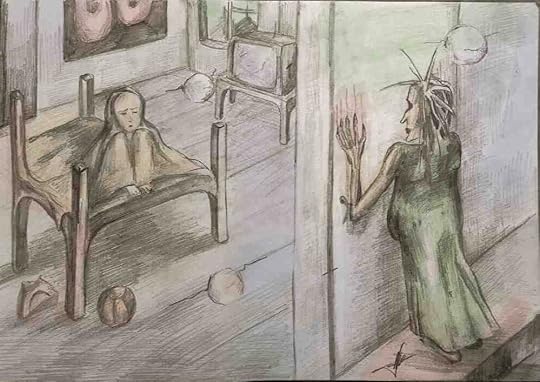 (C) Mana AE, 2013
(C) Mana AE, 2013
Published on January 09, 2014 14:14
January 1, 2014
Publication News: Veronica and the Men in Roadside Fiction
My short story "Veronica and the Men" has been published in the Winter issue of Roadside Fiction. Please see the link, and click on the story titles to read them. "Veronica and the Men" is a contemporary story set in London, not typical of my usual genres, and is an amusing satiric story about a young woman coping with the grind of her daily commute and her job:
http://roadsidefiction.com/index.php/roadside-fiction-issue-six/
 Roadside Fiction cover by Tom Darin LiskeyYou can follow Roadside Fiction on Twitter at: https://twitter.com/RoadsideFiction or their Facebook page which is: https://www.facebook.com/roadside.fiction.5This story was written in 2009 and also published in my 2010 "Beyond Twilight" short story collection.This collection is available at Amazon here: http://www.amazon.co.uk/Beyond-Twilight-Fourteen-short-stories-ebook/dp/B0057FKS32Or you can find it at Smashwords: http://www.smashwords.com/books/view/295025
Roadside Fiction cover by Tom Darin LiskeyYou can follow Roadside Fiction on Twitter at: https://twitter.com/RoadsideFiction or their Facebook page which is: https://www.facebook.com/roadside.fiction.5This story was written in 2009 and also published in my 2010 "Beyond Twilight" short story collection.This collection is available at Amazon here: http://www.amazon.co.uk/Beyond-Twilight-Fourteen-short-stories-ebook/dp/B0057FKS32Or you can find it at Smashwords: http://www.smashwords.com/books/view/295025
Published on January 01, 2014 12:06
December 4, 2013
One Thousand and One Nights; or, The Arabian Nights
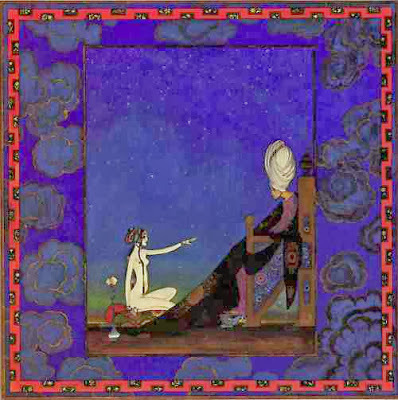
The One Thousand and One Nights, popularly known as The Arabian Nights, is a composite work compiled from Middle Eastern and Indian folklore during the first millennium AD. In its earliest form, its origin was in tales from India and Persia, and then Arab tales were added to it- most of them dating from the period of the Umayyad and Abbasid Caliphates. Many of these stories are based around the adventures of the Caliph of Baghdad, Harun al-Rashid and his vizier (advisor) Ja'far the Barmecide. (Harun al-Rashid was an actual historic figure, although his real-life vizier was Ja'far's father, Yahya. The real Ja'far was mysteriously executed, although it was possibly for an affair with the caliph's sister.) Then later, more folk tales from Syria and Egypt have been added to create as many stories in the Arabian Nights to fill up over a thousand nights. I've read the Penguin Classics English Translationby Malcolm C.Lyons and Ursula Lyons, with an introduction and annotations by Robert Irwin.
 The most famous stories from the Nights that most people would immediately recognise are Aladdin and the Magic Lamp; Ali Baba and the Forty Thieves; and the Seven Voyages of Sindbad. The Nights have had a huge influence on Western literature and the arts due to their imaginative appeal and the attraction of the exotic, or the Oriental- from novels and film to Disney cartoons (Aladdin) and video games (Prince of Persia). These stories have this in common with children's fairy tales by the Brothers Grimm, which gave us Cinderella, Snow White and the Seven Dwarfs and Tom Thumb. As we enter the Christmas pantomime season, Aladdin, along with Cinderella, is a popular pantomime story.
The most famous stories from the Nights that most people would immediately recognise are Aladdin and the Magic Lamp; Ali Baba and the Forty Thieves; and the Seven Voyages of Sindbad. The Nights have had a huge influence on Western literature and the arts due to their imaginative appeal and the attraction of the exotic, or the Oriental- from novels and film to Disney cartoons (Aladdin) and video games (Prince of Persia). These stories have this in common with children's fairy tales by the Brothers Grimm, which gave us Cinderella, Snow White and the Seven Dwarfs and Tom Thumb. As we enter the Christmas pantomime season, Aladdin, along with Cinderella, is a popular pantomime story. The frame story for the entire One Thousand and One Nightscollection is that the Princess Shahrazad (also spelt as Scheherazade) tells a vast number of tales to King Shahriyar to postpone her execution. Every day Shahriyar would marry a new virgin, and every day he would send yesterday's wife to be executed by beheading. This was done in anger, a form of misogynistic revenge after he found out that his first wife was unfaithful to him. He had killed over a thousand such women by the time he was introduced to Shahrazad, the daughter of his vizier. Shahrazad asks to spend the night with the King, and on the first night begins her first tale. At dawn, she breaks off from her story, and asks permission to be allowed to finish it on the following night. Enraptured by her tale, the King grants her request and so the next night she finishes her story and begins a new one, which she also leaves unfinished by dawn- keeping herself alive by the process. This is the premise for the continuation of the tales.
The frame story for the entire One Thousand and One Nightscollection is that the Princess Shahrazad (also spelt as Scheherazade) tells a vast number of tales to King Shahriyar to postpone her execution. Every day Shahriyar would marry a new virgin, and every day he would send yesterday's wife to be executed by beheading. This was done in anger, a form of misogynistic revenge after he found out that his first wife was unfaithful to him. He had killed over a thousand such women by the time he was introduced to Shahrazad, the daughter of his vizier. Shahrazad asks to spend the night with the King, and on the first night begins her first tale. At dawn, she breaks off from her story, and asks permission to be allowed to finish it on the following night. Enraptured by her tale, the King grants her request and so the next night she finishes her story and begins a new one, which she also leaves unfinished by dawn- keeping herself alive by the process. This is the premise for the continuation of the tales.

Stories stand alone, or are part of a cycle; often they are set in a framework of stories-within-stories as storytellers beget further storytellers. There are a vast array of characters (from beggars and caliphs, to barbers and sultans) and locations (caves, underground chambers, mountain peaks, castles, palaces, deserts; the cities of Cairo, Baghdad, Basra) within the Nights, and a broad range of genres: romance, comedy, heroic, supernatural, fantasy, didactic, religious parable and even science fiction, as I will explain.
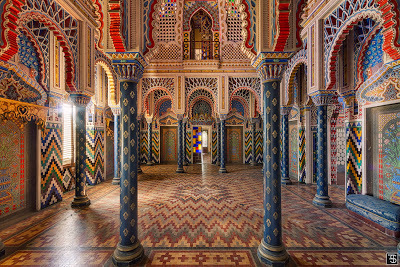
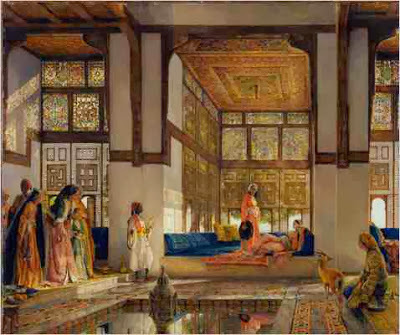
 In my mind, the Nights conjure stories of terrifying turbaned genies (jinnis); magic lamps and flying carpets; warriors leading vast armies; mysterious veiled women; horse-riding Bedouins crossing the sand dunes of endless deserts; towering minarets by twilight beneath a Persian moon; Sindbad encountering weird sea monsters upon his epic voyages; crafty merchants selling their wares at crowded markets. The Nights does not disappoint, it is all of these and more- there are tales of beautiful princesses and handsome princes; locked doors which must not be opened; genies (jinni) and demons (ifrits); sorcerers and magic; clever thieves; disastrous shipwrecks and treks across mountains and deserts. There are also fantastic, mythical monsters such as the Rukh (roc in English): a giant bird which is so huge it can carry an elephant. The end result of such a variety of stories is a fascinating literary melting pot of Arab, Persian and Indian culture.
In my mind, the Nights conjure stories of terrifying turbaned genies (jinnis); magic lamps and flying carpets; warriors leading vast armies; mysterious veiled women; horse-riding Bedouins crossing the sand dunes of endless deserts; towering minarets by twilight beneath a Persian moon; Sindbad encountering weird sea monsters upon his epic voyages; crafty merchants selling their wares at crowded markets. The Nights does not disappoint, it is all of these and more- there are tales of beautiful princesses and handsome princes; locked doors which must not be opened; genies (jinni) and demons (ifrits); sorcerers and magic; clever thieves; disastrous shipwrecks and treks across mountains and deserts. There are also fantastic, mythical monsters such as the Rukh (roc in English): a giant bird which is so huge it can carry an elephant. The end result of such a variety of stories is a fascinating literary melting pot of Arab, Persian and Indian culture.
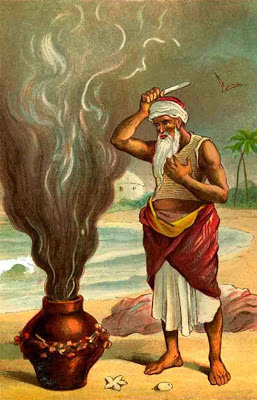

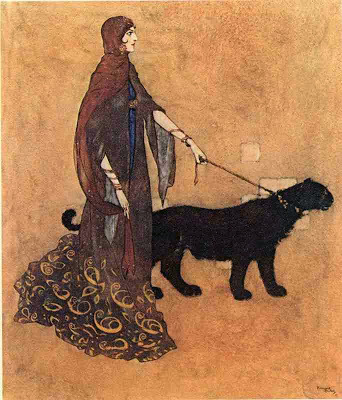
I have already mentioned Harun al-Rashid, the caliph of Baghdad and his vizier Ja'far the Barmecide. In modern adaptations of Arabian Nights stories, such as Disney's Aladdin and the video game Prince of Persia, Ja'far has become a sinister and malevolent figure. Although there are evil viziers, malicious sorcerers and frightening jinni aplenty within the Nights, Ja'far is a much more benevolent character in the original tales. He is a trusted adviser to the Caliph, who is a master of disguise. Al-Rashid likes to go abroad in his city of Baghdad at night, for the purpose of seeking out adventures or so that he may hear tales from others dwelling within the city, beyond the bounds of his palace.
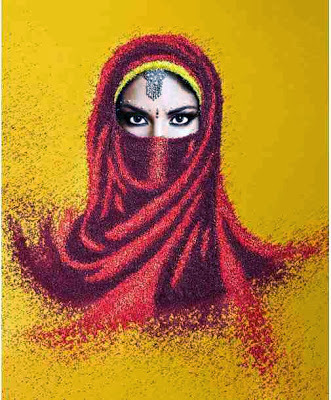
 Obviously there are close to a thousand tales that I could describe, but I wanted to focus on a small collection of stories that I found most interesting. It is the stories with fantasy and supernatural elements that I most enjoy in the Arabian Nights, and while there are plenty of these there are several which stand out in particular.
Obviously there are close to a thousand tales that I could describe, but I wanted to focus on a small collection of stories that I found most interesting. It is the stories with fantasy and supernatural elements that I most enjoy in the Arabian Nights, and while there are plenty of these there are several which stand out in particular.

 There is the story of Ali the Cairene merchant, which is a very early example of a "haunted house" tale, as well as being typical of the many stories within the Arabian Nights describing a character experiencing poverty, who through luck or supernatural means, rapidly gains a fortune. In Ali's case he has been a spendthrift who has wasted his money. After reducing his family to poverty, Ali abandons them in search of better luck, and travels to Baghdad. After pretending his goods have been stolen, a fellow merchant takes pity on Ali. He gives him a choice of houses to stay in- but the one that Ali chooses is apparently haunted and cursed, and whoever stays there is always found dead the next morning. In a suicide bid, Ali insists he must stay there. In the middle of the night, a disembodied voice speaks to him and says that it has been waiting for him. It asks him if it should send down the gold, and when Ali responds to ask where it is, gold coins pour out on the floor from nowhere. As it turns out, the spirit inhabiting the house was waiting for him especially, and it was Ali's destiny to receive the blessings of this good fortune since 'ancient times'. Previous occupants of the house were too terrified to answer, and so the spirit killed them. Ali then seeks out his family again and invites them to share in his new-found wealth.
There is the story of Ali the Cairene merchant, which is a very early example of a "haunted house" tale, as well as being typical of the many stories within the Arabian Nights describing a character experiencing poverty, who through luck or supernatural means, rapidly gains a fortune. In Ali's case he has been a spendthrift who has wasted his money. After reducing his family to poverty, Ali abandons them in search of better luck, and travels to Baghdad. After pretending his goods have been stolen, a fellow merchant takes pity on Ali. He gives him a choice of houses to stay in- but the one that Ali chooses is apparently haunted and cursed, and whoever stays there is always found dead the next morning. In a suicide bid, Ali insists he must stay there. In the middle of the night, a disembodied voice speaks to him and says that it has been waiting for him. It asks him if it should send down the gold, and when Ali responds to ask where it is, gold coins pour out on the floor from nowhere. As it turns out, the spirit inhabiting the house was waiting for him especially, and it was Ali's destiny to receive the blessings of this good fortune since 'ancient times'. Previous occupants of the house were too terrified to answer, and so the spirit killed them. Ali then seeks out his family again and invites them to share in his new-found wealth.
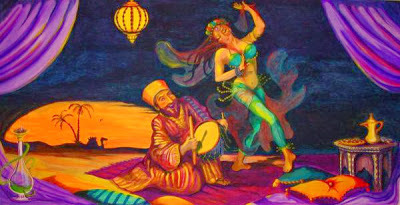
Another interesting story and a good example of a 'fantasy' tale within the Arabian Nights is the story of Abd Allah of the Land and Abd Allah of the Sea. This is about a secret world of water-folk living in the depths of the sea and oceans, a marine civilisation. Abd Allah of the Land is a poor fisherman with a large family to feed, whose only possession is a large fishing net. He is in debt to the baker for food for his family, but every day he takes his net to the sea and catches nothing, until one day he catches a merman in his net, who tells him that his name is also Abd Allah- Abd Allah of the Sea. The fisherman agrees to let the merman go, who in return agrees to be his friend and brings him precious jewels from the bottom of the ocean, which make Abd Allah of the Land rich. Then the merman invites him to visit his people in the sea, giving the fisherman a magic ointment which allows him to walk underneath the waves and within the water without drowning. The water-folk are fascinated by, and laugh at, Abd Allah of the Land because he doesn't have a tail. At the end of the story the fisherman is abandoned by his strange friend because 'land people' mourn when someone dies- the water-folk celebrate a death, because life is only one transitory stage and God 'has taken back his deposit'.
 The Adventures of Buluqiya, as told to Hasib Karim al-Din by the Snake Queen, gives an insight into Islamic cosmology: Earth's place within the universe is explained by the existence of the following-there is Mount Qaf, which is the mountain at the end of the world and which encircles the Earth, where King Solomon sleeps with a magic ring on his finger; beyond it there is The White Land, where the Muslim jinni fight the Unbeliever Jinni; there are Seven layers of Hell, separated by a thousand-year journey (Jahannam, where Muslims who disobey God's command and die without repenting are sent; Lazan, for the Unbelievers; Jahim- for Gog and Magog, evil monsters or demons; Al-Sa'ir- for the hordes of Satan; Saqar- for those who abandon prayer; al-Hutama - for Jews and Christians; and the seventh, al-Hawiya, for hypocrites. Hell consists of vast lands of fire and castles, filled with countless torments); The Angel Michael controls the succession of day and night, and behind Qaf there is a mountain range of snow and ice stretching the distance of a five hundred year journey, protecting the world from the fires of hell; beyond that there are forty lands each with their own Angels, part of seven layers held up by another Angel, who is set on a Rock. Beneath the Rock there is a Bull, which is resting on a Fish. Beneath the Fish there is an Ocean, and beneath that a huge region of Air. Below that there is a giant snake called Falaq, who would devour and swallow everything were it not for its fear of God.
The Adventures of Buluqiya, as told to Hasib Karim al-Din by the Snake Queen, gives an insight into Islamic cosmology: Earth's place within the universe is explained by the existence of the following-there is Mount Qaf, which is the mountain at the end of the world and which encircles the Earth, where King Solomon sleeps with a magic ring on his finger; beyond it there is The White Land, where the Muslim jinni fight the Unbeliever Jinni; there are Seven layers of Hell, separated by a thousand-year journey (Jahannam, where Muslims who disobey God's command and die without repenting are sent; Lazan, for the Unbelievers; Jahim- for Gog and Magog, evil monsters or demons; Al-Sa'ir- for the hordes of Satan; Saqar- for those who abandon prayer; al-Hutama - for Jews and Christians; and the seventh, al-Hawiya, for hypocrites. Hell consists of vast lands of fire and castles, filled with countless torments); The Angel Michael controls the succession of day and night, and behind Qaf there is a mountain range of snow and ice stretching the distance of a five hundred year journey, protecting the world from the fires of hell; beyond that there are forty lands each with their own Angels, part of seven layers held up by another Angel, who is set on a Rock. Beneath the Rock there is a Bull, which is resting on a Fish. Beneath the Fish there is an Ocean, and beneath that a huge region of Air. Below that there is a giant snake called Falaq, who would devour and swallow everything were it not for its fear of God.

Most interestingly of all, I mentioned earlier that there were stories in the Nights that could almost be put into the science fiction genre. There are three in particular that deserve a closer look. The first of these is the Third Dervish's Tale (also known as the Third Qalander's's Tale). He describes his experiences of being shipwrecked on the 'Magnetic Mountain', an island of "black stone", where "God Almighty has set a secret power that attracts everything made of iron". Also, "by the shore there is a vaulted dome of brass set on ten columns and on top of this is a rider and his horse, both made of brass" This rider kills all who comes his way. Later on in the Dervish's Tale, there is also a boatman constructed of brass, who automatically rows silently across the sea, "with a lead tablet on his breast, inscribed with names and talismans". Both descriptions sound like metallic/clockwork automata, or 'robots'. The Dervish eventually finds himself in a palace with forty girls, the daughters of Kings. There are thirty-nine chambers he may enter, but a fortieth that he must never go into. The women allow him to stay at the palace while they are away, but he must not open the fortieth door. Eventually, his curiosity gets the better of him and he enters the fortieth chamber. He finds a strange 'black horse' which he sits on, and when he strikes it, it issues a neigh like 'rumbling thunder' and flies off with him, carrying him up into the sky. It sounds more like a flying aircraft than an actual horse. When it finally lands on the roof of another building, its 'tail' accidently strikes the Dervish and causes him to lose an eye.
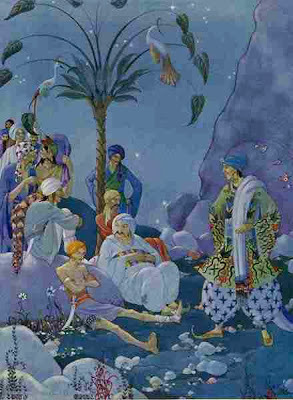 This idea occurs again in the second story in the Nights that I wanted to focus on, which is called The Ebony Horse. Wise men bring gifts to a King and his son, and the third of them brings a 'horse' made of ebony and ivory. "When a man mounts it, it will take him to whatever land he wants." A screw or 'button' makes it rise into the air. The prince "started to examine all parts of the horses body...there was a protuberance like a cock's comb on its right shoulder and another on its left." When he touches these features, the climb takes him far above the ground or allows him to descend again. Again, it appears that the "Ebony Horse" is some sort of electronic flying craft. Bearing in mind that these stories were created and compiled in the early centuries of the first millennium AD, from the period of the Romans to the Vikings in European history, these details are really interesting.
This idea occurs again in the second story in the Nights that I wanted to focus on, which is called The Ebony Horse. Wise men bring gifts to a King and his son, and the third of them brings a 'horse' made of ebony and ivory. "When a man mounts it, it will take him to whatever land he wants." A screw or 'button' makes it rise into the air. The prince "started to examine all parts of the horses body...there was a protuberance like a cock's comb on its right shoulder and another on its left." When he touches these features, the climb takes him far above the ground or allows him to descend again. Again, it appears that the "Ebony Horse" is some sort of electronic flying craft. Bearing in mind that these stories were created and compiled in the early centuries of the first millennium AD, from the period of the Romans to the Vikings in European history, these details are really interesting.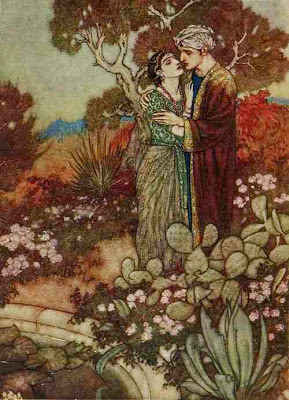 Keeping with the theme of brass, the final intriguing story in the Arabian Nights with science fiction elements is The City of Brass. Two characters, Musa and Abd al-Samad, go in search of the city, where King Solomon allegedly trapped jinni (genies) in brass bottles. While travelling across the desert, they encounter a giant brass figure who points in the right direction of the city after a button is pressed. On the way there, they then encounter a strange figure- a trapped entity- imprisoned within a pillar half-buried in the sand. This being speaks to them and also confirms they are heading in the right direction of the city. When they and their retinue arrive at the City of Brass, they find peculiar relics and odd devices, remnants of some ancient science. I was also reminded of the Shelley poem"Ozymandias" after reading this particular story, with the echoes of a once-great civilisation. There are preserved corpses in the chambers of the city, including one of a beautiful woman with her eyeballs removed and the sockets filled with quicksilver to give the impression her eyes are moving, and that she is still alive. There are non-speaking brass figures which again appear to be depictions of clockwork automata or robots. These kill Musa and Abd al-Samad's companion Talib when he wants to steal treasure from the city.
Keeping with the theme of brass, the final intriguing story in the Arabian Nights with science fiction elements is The City of Brass. Two characters, Musa and Abd al-Samad, go in search of the city, where King Solomon allegedly trapped jinni (genies) in brass bottles. While travelling across the desert, they encounter a giant brass figure who points in the right direction of the city after a button is pressed. On the way there, they then encounter a strange figure- a trapped entity- imprisoned within a pillar half-buried in the sand. This being speaks to them and also confirms they are heading in the right direction of the city. When they and their retinue arrive at the City of Brass, they find peculiar relics and odd devices, remnants of some ancient science. I was also reminded of the Shelley poem"Ozymandias" after reading this particular story, with the echoes of a once-great civilisation. There are preserved corpses in the chambers of the city, including one of a beautiful woman with her eyeballs removed and the sockets filled with quicksilver to give the impression her eyes are moving, and that she is still alive. There are non-speaking brass figures which again appear to be depictions of clockwork automata or robots. These kill Musa and Abd al-Samad's companion Talib when he wants to steal treasure from the city.
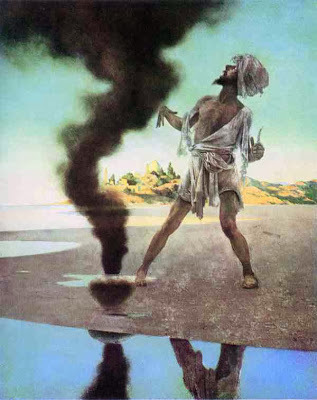
Finally, one more interesting story from the Nights which is worth looking at is The Slave Girl Tawaddud, which is an interesting mini-encyclopaedia of scientific/religious/scholarly thought and knowledge in Persian/Arabian culture during this period.
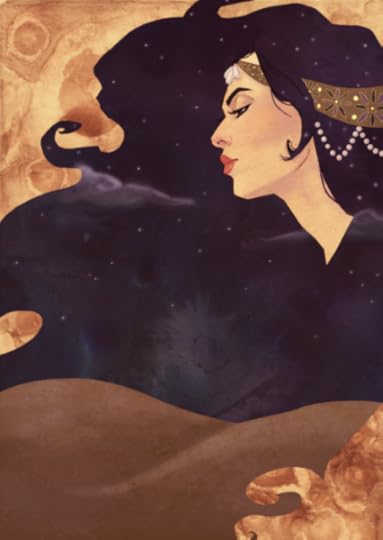
Published on December 04, 2013 18:34
December 2, 2013
Reflections on "We3" by Grant Morrison and Frank Quitely
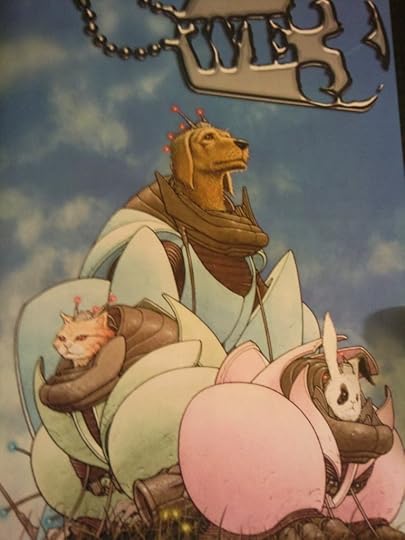 I recently enjoyed reading "We3", a graphic novel by Grant Morrison (writer) and Frank Quitely* (artist). The story premise is that a shadowy branch or agency of the US military and government are using pets as part of covert experiments in clandestine warfare operations, turning them into cyborg killing machines. "We3" are a dog, cat and rabbit (formerly known as Bandit, Tinker and Pirate, kidnapped pets from off the street) who have been 'enhanced' with metallic exo-skeletal plate armour, powerful weaponry and brain surgery to boost their intelligence. They can now talk, and communicate in a peculiar form of text-speak. The dog is the most self-aware and articulate. They have been transformed into cyborg assassins, trained and programmed to eliminate potential targets.
I recently enjoyed reading "We3", a graphic novel by Grant Morrison (writer) and Frank Quitely* (artist). The story premise is that a shadowy branch or agency of the US military and government are using pets as part of covert experiments in clandestine warfare operations, turning them into cyborg killing machines. "We3" are a dog, cat and rabbit (formerly known as Bandit, Tinker and Pirate, kidnapped pets from off the street) who have been 'enhanced' with metallic exo-skeletal plate armour, powerful weaponry and brain surgery to boost their intelligence. They can now talk, and communicate in a peculiar form of text-speak. The dog is the most self-aware and articulate. They have been transformed into cyborg assassins, trained and programmed to eliminate potential targets.
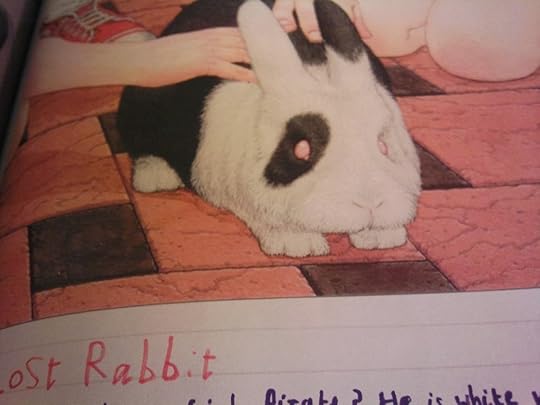


The reader is also introduced to rats who were clearly the first phase of the experiment- one rat has a drill for a head- and the reader is also shown the next horrific upgrade in the "animal as killing machine project", another cyborg which is eventually sent out in pursuit of We3 once it is decided they are obsolete.
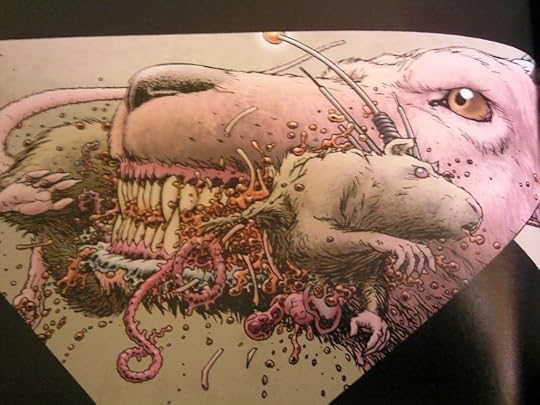
We3's existence within this project begins to fragment when the General in charge of the operation decides that they are to be 'decommissioned', despite their success in carrying out military assassinations on behalf of the US government. However, it dawns on "We3" themselves that 'decommissioning' means their termination. Their guilt-ridden handler and trainer allows them to escape as they embark on a futile quest to find 'home', whatever or wherever that can possibly be for them now. Disastrously, this means that they are pursued by military forces desperate to eliminate them and silence any leaks of their covert operations. This is a pursuit that leads to predictable chaos, carnage and spectacular violence. In their desperation, the military agency send out the latest cyborg-animal 'upgrade' to pursue them, which leads to a devastating climax to the pursuit (you will have to read it yourself to find out what happens, but it doesn't end well).
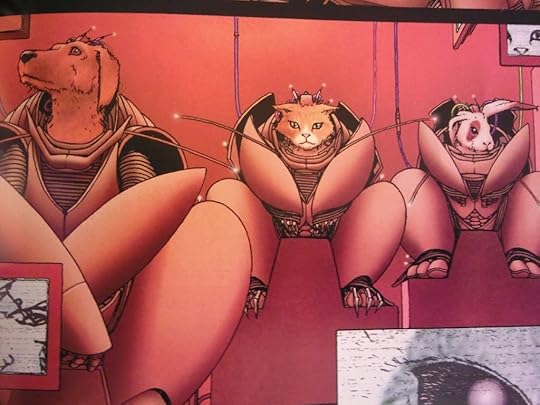
I did wonder why the military agency and their scientists stole people's pets for their covert operations, rather than taking strays or animals from pet shops/cat & dog homes, but perhaps that detail added to the poignancy of the story.
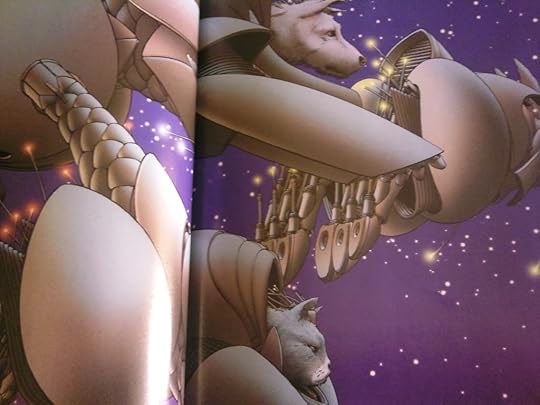
"We3" asks questions about the nature of warfare; what we willingly allow governments to do in our name; manipulation of our environment and resources; authority and control; the cynical, selfish, exploitative and destructive nature of humanity; and the relationship between human beings and animals. Essentially it is RoboCop with animals, but it also bears some similarities to the work of Richard Adams- most notably the novel The Plague Dogs.
*I've reproduced some plates of Frank Quitely's artwork here in this post.
Published on December 02, 2013 19:30
October 5, 2013
"Whispers on the Airwaves" published at Darker Times
Publication News: My SF/Horror short story "Whispers on the Airwaves" has been published by Darker Times. It was a runner-up in their September competition, and you can read my story online here: http://www.darkertimes.co.uk/winners/ss-runner-up-3-sept-2013.aspx
You can see the full list of winners and runners up for the website's September competition here: http://www.darkertimes.co.uk/winners.aspx
The Darker Times website is run by the author Jessica Grace Coleman, please do check out her website and links to her published works here:http://jessicagracecoleman.wordpress.com/
You can see the full list of winners and runners up for the website's September competition here: http://www.darkertimes.co.uk/winners.aspx
The Darker Times website is run by the author Jessica Grace Coleman, please do check out her website and links to her published works here:http://jessicagracecoleman.wordpress.com/

Published on October 05, 2013 12:24
Reading Matters
"Reading Matters"- yes, I know this pun sounds a little bit Partridgean- but I like it, so there. I finished a couple of novels recently which I was impressed by, and I wanted to write some brief lines about them. The first one was In Arcadia, by the Nigerian writer Ben Okri. I had not been particularly impressed by the blurb and the premise for the book (more fool me), but upon reading the first few pages I quickly became absorbed.
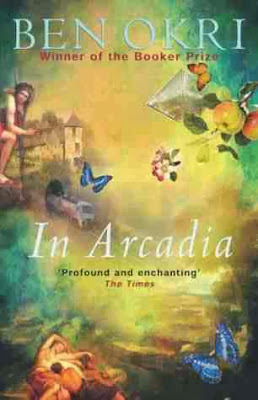 The basic plot of Okri's novel is that a group of TV and film-makers receive instructions from a mysterious and elusive individual named Malasso to travel from London to Paris and along the way create a film to mark aspects of their journey. The book and its themes were inspired by two paintings by Nicolas Poussin: "Et in Arcadia Ego" (Roughly translated, Even in Arcadia, There Am I) and most notably, the second painting under this title, known also as the "Arcadian Shepherds", which hangs in the Louvre.
The basic plot of Okri's novel is that a group of TV and film-makers receive instructions from a mysterious and elusive individual named Malasso to travel from London to Paris and along the way create a film to mark aspects of their journey. The book and its themes were inspired by two paintings by Nicolas Poussin: "Et in Arcadia Ego" (Roughly translated, Even in Arcadia, There Am I) and most notably, the second painting under this title, known also as the "Arcadian Shepherds", which hangs in the Louvre.
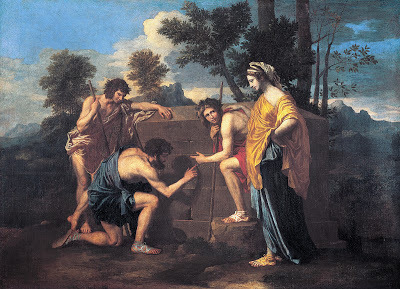 Poussin's painting which is central to the themes of Okri's novel Indeed, the Louvre and the painting itself prove to be the final destination for Okri's group of travellers, or should we say 'pilgrims'. For the novel is essentially a modern pilgrimage story, and along the way the principal characters reveal aspects of themselves as they consider the purpose and meaning of existence, the pursuit of happiness in life and what constitutes their own personal "Arcadia" (which could be a material or spiritual utopia). The primary character and principal narrator is a TV executive named Lao, who begins the novel as angry and cynical, drinking heavily and behaving obnoxiously to those around him, before experiencing a spiritual re-awakening. The plot is effectively secondary to Okri's philosophical discussions and ruminations upon the nature and meaning of existence. The account of their journey provides a framework for this, and I found it fascinating and thought-provoking.
Poussin's painting which is central to the themes of Okri's novel Indeed, the Louvre and the painting itself prove to be the final destination for Okri's group of travellers, or should we say 'pilgrims'. For the novel is essentially a modern pilgrimage story, and along the way the principal characters reveal aspects of themselves as they consider the purpose and meaning of existence, the pursuit of happiness in life and what constitutes their own personal "Arcadia" (which could be a material or spiritual utopia). The primary character and principal narrator is a TV executive named Lao, who begins the novel as angry and cynical, drinking heavily and behaving obnoxiously to those around him, before experiencing a spiritual re-awakening. The plot is effectively secondary to Okri's philosophical discussions and ruminations upon the nature and meaning of existence. The account of their journey provides a framework for this, and I found it fascinating and thought-provoking. The second novel I read was When We Were Orphans by Kazuo Ishiguro. It was a strange, haunting novel set in Shanghai and London during the 1920s and 1930s, on the eve of the Second World War. The sole -and unreliable- narrator of this novel is Christopher Banks, an English detective who grew up in Shanghai. He is forced to leave China when he is still a child when both his parents mysteriously disappear. In England, he attends school and reaches adulthood as an orphan, and yet it is clear the mystery of his parents vanishing influences his choice of vocation as a detective. After making his name in London and becoming part of high society, he decides to return to Shanghai and solve the mystery of what happened to them.
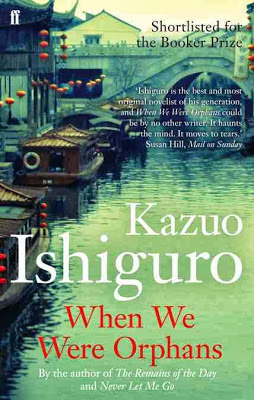 The novel is fascinating because of the sinister undercurrent that lurks behind and beneath the old-fashioned dialogues and mannerisms of its protagonists, not to mention Christopher Banks' obviously unreliable recollections of the past and dubious narration of the present day; at times he seems to have a fragile grasp upon reality. Old school friends remember him as strange and silent where he is convinced he had many friends and fully participated at school; he reacts with anger when told he showed weakness as a child; he seems to have difficulty trusting women and forming relationships with them; a young girl whom he adopts and becomes the guardian for, tells him she must "look after him" when he is older; later on in the novel, he seems oblivious to the conflict taking place around him between the Chinese and Japanese soldiers as he desperately searches for his parents; he confuses a wounded Japanese soldier with Akira, his childhood friend from Shanghai- although as readers we are never quite certain of the reality in this instance. There is a particularly disturbing and tragic scene in the novel at this point, which takes place within the bombed Chinese slums of Shanghai known as The Warren.
The novel is fascinating because of the sinister undercurrent that lurks behind and beneath the old-fashioned dialogues and mannerisms of its protagonists, not to mention Christopher Banks' obviously unreliable recollections of the past and dubious narration of the present day; at times he seems to have a fragile grasp upon reality. Old school friends remember him as strange and silent where he is convinced he had many friends and fully participated at school; he reacts with anger when told he showed weakness as a child; he seems to have difficulty trusting women and forming relationships with them; a young girl whom he adopts and becomes the guardian for, tells him she must "look after him" when he is older; later on in the novel, he seems oblivious to the conflict taking place around him between the Chinese and Japanese soldiers as he desperately searches for his parents; he confuses a wounded Japanese soldier with Akira, his childhood friend from Shanghai- although as readers we are never quite certain of the reality in this instance. There is a particularly disturbing and tragic scene in the novel at this point, which takes place within the bombed Chinese slums of Shanghai known as The Warren.The majority of critics and even Ishiguro himself do not regard this book as his best work, but I found the novel moving and extremely affecting, particularly as it reaches its conclusion. The only criticism I would offer is that occasionally the prose style grated with me: some of the dialogues were stilted as if extracted from a 1930s black and white film; one or two sections were unintentionally- not intentionally, surely?- humorous; at times the narrator Christopher Banks' apparent lack of self-awareness and grasp upon reality seemed too far-fetched to be convincing. Aside from that, I thought it was a fine novel- and I found myself still thinking about it after I had put it down. In fact, that is true for both of the novels I have talked about here, (without giving away too many crucial spoilers!), and so I would definitely recommend both of them.
Published on October 05, 2013 12:02
September 10, 2013
The Three Mulla-Mulgars (Illustrations)
In relation to my previous post on Lord of Darkness, I found some fantastic illustrations for different editions of The Three Mulla-Mulgars (The Three Royal Monkeys) by Walter de la Mare, which I thought I would share with you:
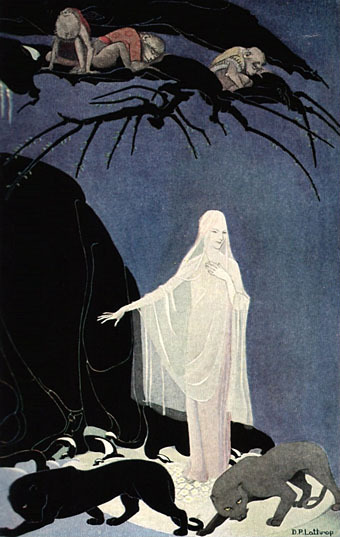
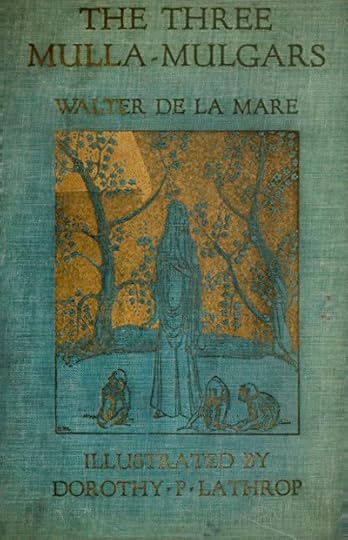

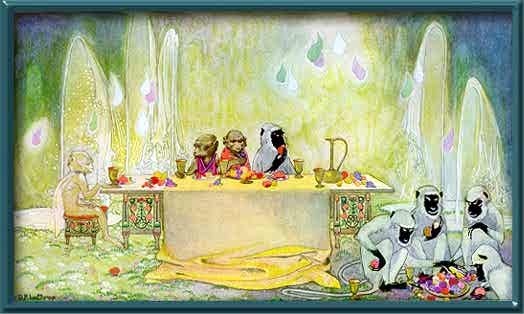
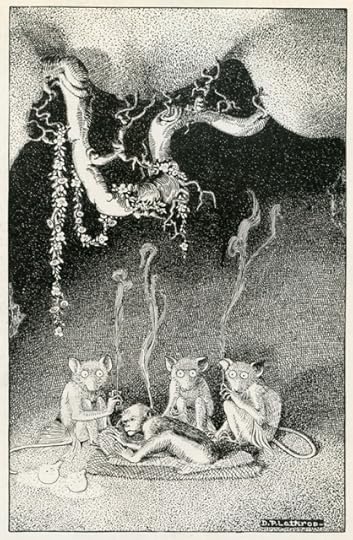
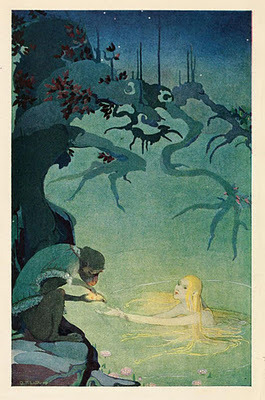
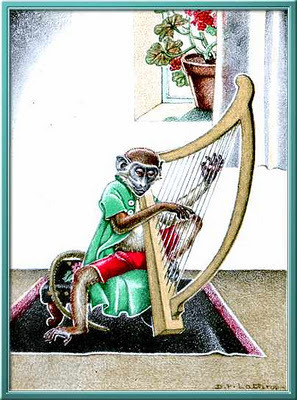
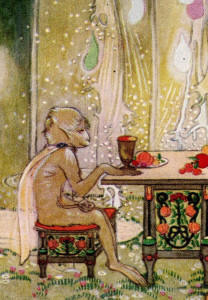
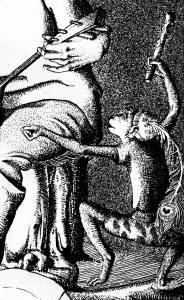
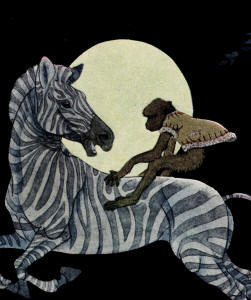
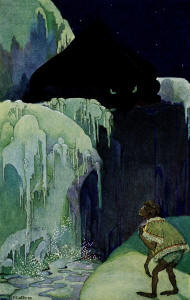











Published on September 10, 2013 06:06
September 9, 2013
Lord of Darkness, by Robert Silverberg
Introduction
The first 'adult' novel that I ever read (or more accurately, perhaps, attempted to read) was Lord of Darkness by Robert Silverberg. I recall that it was a borrowed library book that was lying around the house. Perhaps the cover, which I can remember very clearly, was what attracted me:
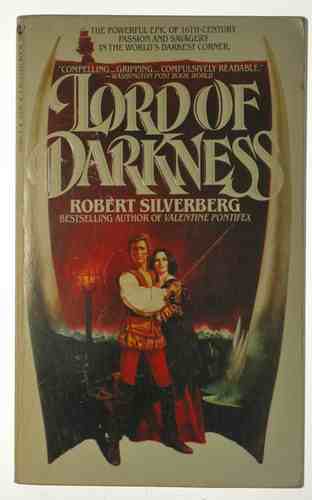 The cover of the original edition, which I remember well from the library copy at our house when I was a kid. The cover shows Andrew Battell and Dona Teresa, the Portuguese femme fatale who nurses him back to health in the colony
The cover of the original edition, which I remember well from the library copy at our house when I was a kid. The cover shows Andrew Battell and Dona Teresa, the Portuguese femme fatale who nurses him back to health in the colony
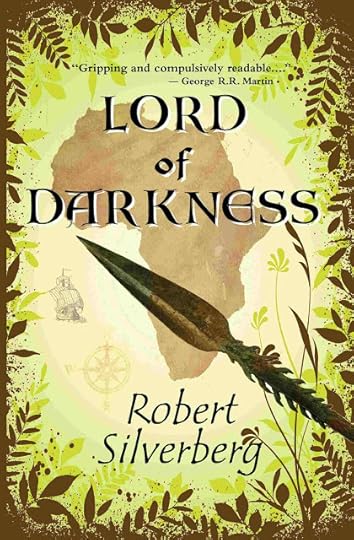 The edition that I currently own, published in 2013 by Nonstop Press I'm not sure how old I was when I tried to read it. Eight or nine years old, perhaps? When re-reading it years later, I was very surprised by some of the explicit content. I didn't remember it at all from the first time I had read the book. Maybe I had not understood it, or had not found those particular sections of the book interesting. What had remained with me was a mysterious tale of adventure taking place in faraway, exotic climes. Now that, to an eight or nine year old boy, was very interesting.
The edition that I currently own, published in 2013 by Nonstop Press I'm not sure how old I was when I tried to read it. Eight or nine years old, perhaps? When re-reading it years later, I was very surprised by some of the explicit content. I didn't remember it at all from the first time I had read the book. Maybe I had not understood it, or had not found those particular sections of the book interesting. What had remained with me was a mysterious tale of adventure taking place in faraway, exotic climes. Now that, to an eight or nine year old boy, was very interesting.Summary
Lord of Darkness is set during the late sixteenth century/early seventeenth centuries and is about an Elizabethan sailor, buccaneer and explorer named Andrew Battell. After setting off on a merchant voyage to seek his fortune, Battell is captured by pirates in South America and drawn into the imperialist expeditions and machinations of the Portuguese, now allies with the Spanish with whom Elizabethan England are at war. He is taken to West Africa, to the region which is now modern day Angola, and becomes a prisoner of the Portuguese colonisers. He tries to earn his freedom by acting as a pilot for their sailing explorations along the African coastline. The novel describes his various adventures, imprisonments, ill fortune, and numerous love affairs as he attempts to escape and find his way back to England. The novel considers the weighty themes of imperialism, colonisation, racism, slavery and racial/cultural/national identity while at the same time being a gripping adventure story. The strangest, weirdest section of the novel is toward the end of the book, and this details Battell's experiences living with a flesh-eating tribe of warrior-cannibals deep in the Angolan jungle- the Jaqqa.
Background
The inspiration for Silverberg's novel came from his own discovery of a Walter de la Mare picaresque fantasy, "The Three Mulla-Mulgars". Mulgars are De la Mare's term for Monkeys in his own novel. This describes the adventures of three young Mulgars (monkeys) of royal blood who travel across Africa to reach the Arakkaboa Mountains where their dead father's brother Assassimon rules a Kingdom of Animals. Silverberg's imagination was, as he relates in the 2013 edition of Lord of Darkness which I own, caught by: "the strangeness of (De la Mare's) style and his three Mulgars' journey through nightmare forests and formidable mountain passes." (p.5, Nonstop Press edition, 2013)
The three royal monkeys encounter a human during their journey- an "Oomgar" (Mulgar-talk for 'human'). This human, the only one in De la Mare's story, is Andrew Battle, who turns out to be a God-fearing English sailor. Silverberg initially thought that Battle was a fictional character. This was until later in life, when he researched Elizabethan explorers and voyagers, and came across a 61-page pamphlet published in 1901 by the Hakluyt Society of London (noted for publishing exploration narratives) entitled The Strange Adventures of Andrew Battell of Leigh, in Angola and the Adjoining Regions. De la Mare had briefly used the character in his own story, but Silverberg decided that he wanted to tell Andrew Battell's real story- fleshing out the true historical details which were described in the pamphlet, which Walter de la Mare had obviously also used as a reference source for the character of Andrew Battle in "The Three Mulla-Mulgars". Silverberg himself states in his introduction that: "What could he have been like, this Englishman who spent two decades in the tropic heat of Angola, and dwelled for years amidst a flesh-eating tribe which seemed to him the next thing to devils? Would it be possible to re-invent such a man from the skimpy evidence at hand- to write his own memoir at full length, filling in all that this simple seaman had left unsaid, and much more that he would never have dreamed of saying?" (p.7, Nonstop Press edition, 2013) This re-invention of Battell's personal memoir forms the blend of historical fact and fiction which is Silverberg's novel Lord of Darkness.
Reflections
The novel is rich in historic detail. Without wishing to give too much away regarding the plot, there is a slow build up to introduce the early life of Battell before he is plunged into misadventure under foreign skies, with plenty of memorable scenes that form a precursor to future events (for example, Battell's first sighting of a Jaqqa: "There was about this one man a strangeness and a presence most commanding, and such a sense of silent menace, that made him a sort of Lucifer or Mephistopheles, and I knew at first instant he was nothing ordinary." p.43, Nonstop Press Edition, 2013)- and most notably Battell's encounter with an albino witch doctor, a ndundu:
Indeed this ndundu was passing through the market, sampling this food and that, taking a bite and a bite and tossing away, and all this while he was allowed to go where he pleased. He came within five yards of me and turned to stare, for my blond hair was as strange to him as he was to me. Our eyes met, and his were red, red where mine were blue, the red eyes of a demon from Hell, that I have never seen otherwise.Toward me he did make certain holy gestures, that were like the writhing of a madman, with much waving of the arms and crooking of his fingers. And in a hissing voice, he cried out, an evil croak... (p.102, Nonstop Press Edition, 2013)
The novel becomes, appropriately enough, progressively 'darker' in tone as Battell's Boys-Own style buccaneer adventures slowly descend into Silverberg's take on Joseph Conrad's Heart of Darkness, and the memorable descriptions of the dangerous and mysterious Lord of the Jaqqas, Imbe Calandola. ("...this Calandola, I thought at once, had in him the stuff of majesty...he could capture the souls of men, and make them follow where he willed.")
Silverberg sought to write the novel in an archaic style similar to Elizabethan prose, without using anachronistic language, yet at the same time ensuring that the novel was readable for 20th century/21st century readers. It is an uneven balance at times ("Yet am I grateful for all that Thou hast shown me in that land, even for the pain Thou hast inflicted upon me for my deeper instruction", p.10, Nonstop Press edition, 2013) but on the whole he succeeds.
In my opinion Lord of Darkness is an unfairly neglected novel by Silverberg. This was because he was and is considered predominantly a genre writer of fantasy and science/speculative fiction, most notably for Dying Inside, a dark and melancholic tale about a telepath losing his powers, and for his Majipoor fantasy/SF series. SF enthusiasts who were aware of Silverberg's work were not drawn to what was patently a work of historic fiction ( a tale of buccaneers, explorers and colonial Africa) while readers of historical fiction were unaware of a novel by a SF/Fantasy author that ended up on those particular bookshelves in bookshops/stores.
I will say no more, so as not to spoil the twists and turns of the story for potential readers, and I will merely conclude by saying that Lord of Darkness is a novel which I would highly recommend to fans of historical fiction and adventure stories.
Published on September 09, 2013 14:19



